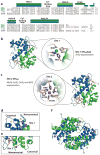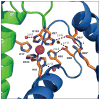Transition Metal Sequestration by the Host-Defense Protein Calprotectin
- PMID: 29925260
- PMCID: PMC6066180
- DOI: 10.1146/annurev-biochem-062917-012312
Transition Metal Sequestration by the Host-Defense Protein Calprotectin
Abstract
In response to microbial infection, the human host deploys metal-sequestering host-defense proteins, which reduce nutrient availability and thereby inhibit microbial growth and virulence. Calprotectin (CP) is an abundant antimicrobial protein released from neutrophils and epithelial cells at sites of infection. CP sequesters divalent first-row transition metal ions to limit the availability of essential metal nutrients in the extracellular space. While functional and clinical studies of CP have been pursued for decades, advances in our understanding of its biological coordination chemistry, which is central to its role in the host-microbe interaction, have been made in more recent years. In this review, we focus on the coordination chemistry of CP and highlight studies of its metal-binding properties and contributions to the metal-withholding innate immune response. Taken together, these recent studies inform our current model of how CP participates in metal homeostasis and immunity, and they provide a foundation for further investigations of a remarkable metal-chelating protein at the host-microbe interface and beyond.
Keywords: S100 protein; antimicrobial activity; host–microbe interaction; metal homeostasis; nutritional immunity.
Figures




References
-
- Waldron KJ, Rutherford JC, Ford D, Robinson NJ. Metalloproteins and metal sensing. Nature. 2009;460:823–30. - PubMed
-
- Weinberg ED. Nutritional immunity. Host’s attempt to withhold iron from microbial invaders. JAMA. 1975;231:39–41. - PubMed
-
- Vogel HJ. Lactoferrin, a bird’s eye view. Biochem Cell Biol. 2012;90:233–44. - PubMed
-
- Goetz DH, Holmes MA, Borregaard N, Bluhm ME, Raymond KN, Strong RK. The neutrophil lipocalin NGAL is a bacteriostatic agent that interferes with siderophore-mediated iron acquisition. Mol Cell. 2002;10:1033–43. - PubMed
Publication types
MeSH terms
Substances
Grants and funding
LinkOut - more resources
Full Text Sources
Other Literature Sources
Miscellaneous

